The brisket is the beef primal most associated with Texas barbecue. It also tends to be the most difficult cut for most people to prepare and consistently produce a tender, juicy, flavorful end product. Briskets are removed from the forequarter of a beef carcass cutting in a line parallel to the backbone through the cartilage in the juncture of the first rib with the sternum bone, continuing the cut across ribs 2-5 (see the diagram below). After cutting through the ribs and the muscles immediately lateral to the ribs, the brisket can be removed by cutting through the natural seam between the remaining muscles. After removal from the forequarter, the remaining portion of the rib and sternum bones are removed along with a layer of fat located immediately underneath, commonly referred to as the “deckle.” A “packer trim” brisket is typically considered one still in the vacuum package as it was delivered from the packer with minimal trimming, especially to the subcutaneous (outside) surface. Today, many briskets are further trimmed to no more than .25 inch of fat before seasoning.
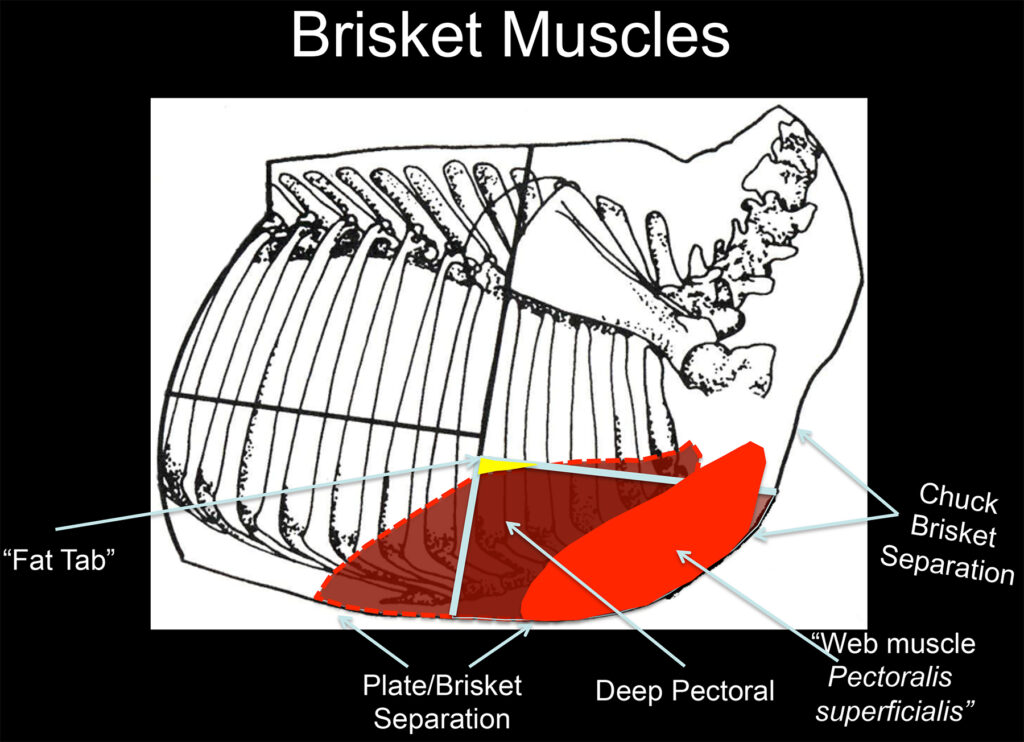
Skeletal Diagram of a Beef forequarter showing where the brisket is located.
The brisket typically contains parts of two major muscles. The
deep pectoral muscle is located on the most interior (medial) surface of the brisket. The conventional method for fabricating briskets includes severing this muscle by making a cut between the 4th and 5th ribs, however, many briskets today have even more of the posterior portion of the
deep pectoral muscle left on the brisket, and the brisket may be cut more ventrally to make a longer narrower style. The
superficial pectoral muscle is located on the exterior (lateral) portion of the brisket and typically has more fat associated with it than the
deep pectoral muscle.
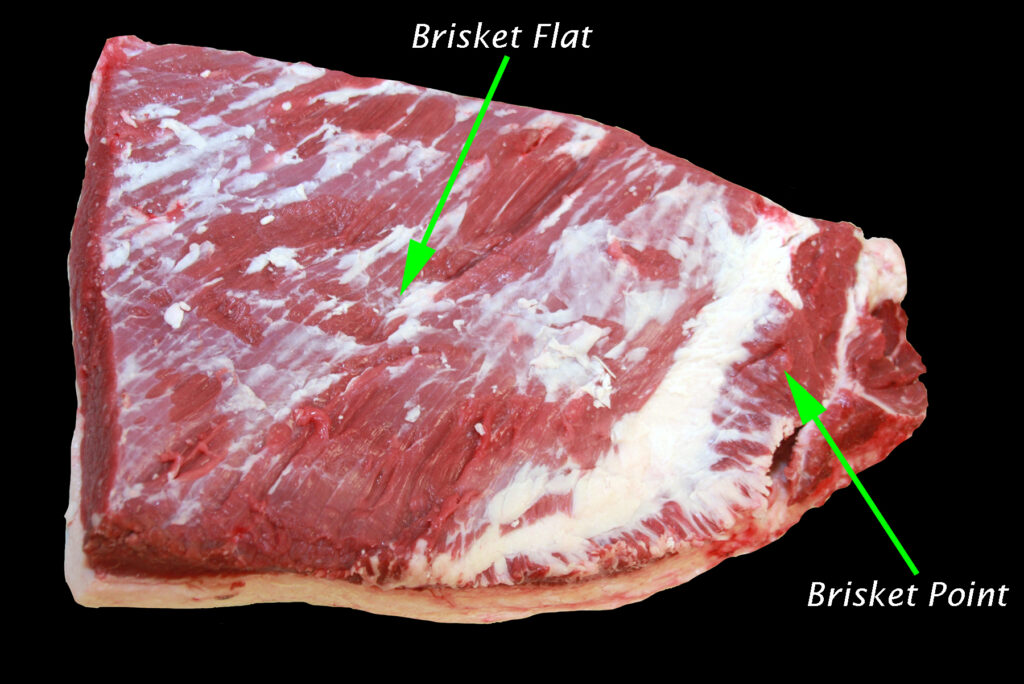
Brisket showing location of point and flat
If a brisket is separated into two portions, they are typically referred to as a brisket flat and a brisket point, however, the definition of these two portions as a retail or foodservice cut is different in different locations. In some presentations, the brisket may be cut into two equal sized (length) pieces by a single knife cut across the brisket. The cut surface on each half will generally have both major muscles exposed, although the cut will have a majority of one muscle or the other depending on whether it is the anterior or posterior end.
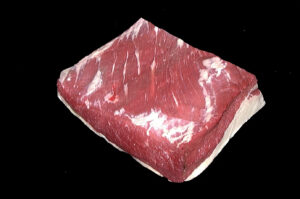 Brisket Flat Half Brisket Flat Half |
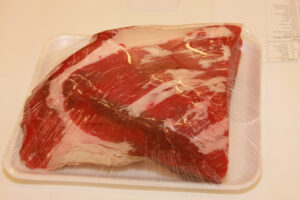 Brisket Point Half Brisket Point Half |
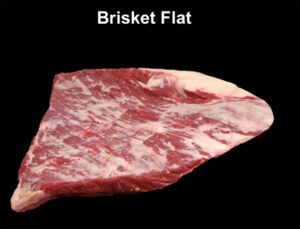 Brisket Flat (whole flat/deep pectoral muscle)
Brisket Flat (whole flat/deep pectoral muscle) |
|
The two muscles (
deep and
superficial pectoral) may also be separated by following the natural seam between the muscles to make a 120A Beef Brisket Flat and a 120B Beef Brisket Point. Both muscles will be somewhat irregular in size and shape when separated in this manner.
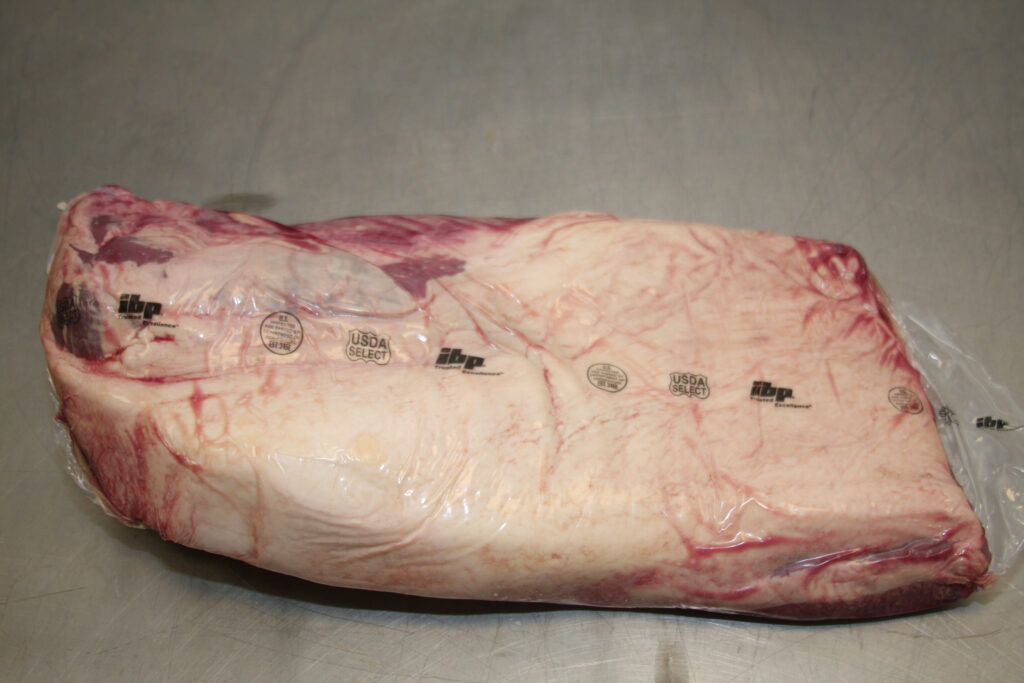
Vacuum Packaged “Packer Trimmed” Brisket
Many of the briskets marketed today are sold in the vacuum package that they were packaged in at the processing plant. The vacuum bag has a high barrier film that maintains the very low level of oxygen achieved during packaging. This inhibits the growth of aerobic bacteria that cause spoilage and thus extends the shelf life or storage life of the meat (assuming it is maintained in a low temperature range). The information printed on the outside of the bag may indicate the company that processed the meat, the inspection legend indicating the product has been inspected and passed by USDA or a state meat inspection program, and may indicate the USDA Quality grade of the brisket.
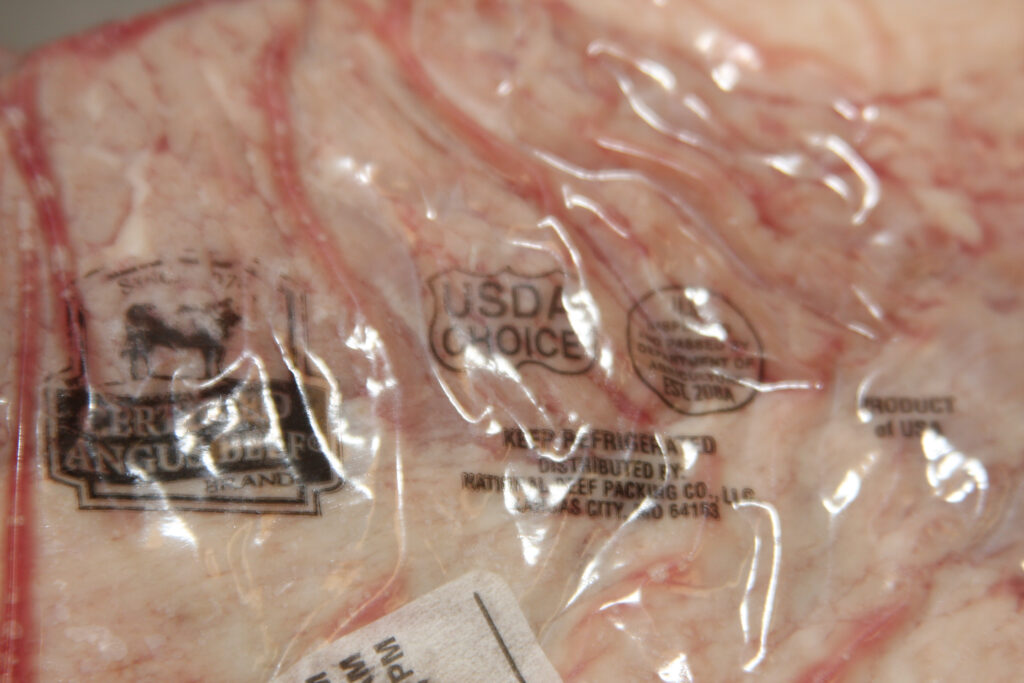
Picture of Brisket package showing brand, grade and inspection legend.
 Skeletal Diagram of a Beef forequarter showing where the brisket is located.
The brisket typically contains parts of two major muscles. The deep pectoral muscle is located on the most interior (medial) surface of the brisket. The conventional method for fabricating briskets includes severing this muscle by making a cut between the 4th and 5th ribs, however, many briskets today have even more of the posterior portion of the deep pectoral muscle left on the brisket, and the brisket may be cut more ventrally to make a longer narrower style. The superficial pectoral muscle is located on the exterior (lateral) portion of the brisket and typically has more fat associated with it than the deep pectoral muscle.
Skeletal Diagram of a Beef forequarter showing where the brisket is located.
The brisket typically contains parts of two major muscles. The deep pectoral muscle is located on the most interior (medial) surface of the brisket. The conventional method for fabricating briskets includes severing this muscle by making a cut between the 4th and 5th ribs, however, many briskets today have even more of the posterior portion of the deep pectoral muscle left on the brisket, and the brisket may be cut more ventrally to make a longer narrower style. The superficial pectoral muscle is located on the exterior (lateral) portion of the brisket and typically has more fat associated with it than the deep pectoral muscle.
 Brisket showing location of point and flat
If a brisket is separated into two portions, they are typically referred to as a brisket flat and a brisket point, however, the definition of these two portions as a retail or foodservice cut is different in different locations. In some presentations, the brisket may be cut into two equal sized (length) pieces by a single knife cut across the brisket. The cut surface on each half will generally have both major muscles exposed, although the cut will have a majority of one muscle or the other depending on whether it is the anterior or posterior end.
Brisket showing location of point and flat
If a brisket is separated into two portions, they are typically referred to as a brisket flat and a brisket point, however, the definition of these two portions as a retail or foodservice cut is different in different locations. In some presentations, the brisket may be cut into two equal sized (length) pieces by a single knife cut across the brisket. The cut surface on each half will generally have both major muscles exposed, although the cut will have a majority of one muscle or the other depending on whether it is the anterior or posterior end.
 Vacuum Packaged “Packer Trimmed” Brisket
Many of the briskets marketed today are sold in the vacuum package that they were packaged in at the processing plant. The vacuum bag has a high barrier film that maintains the very low level of oxygen achieved during packaging. This inhibits the growth of aerobic bacteria that cause spoilage and thus extends the shelf life or storage life of the meat (assuming it is maintained in a low temperature range). The information printed on the outside of the bag may indicate the company that processed the meat, the inspection legend indicating the product has been inspected and passed by USDA or a state meat inspection program, and may indicate the USDA Quality grade of the brisket.
Vacuum Packaged “Packer Trimmed” Brisket
Many of the briskets marketed today are sold in the vacuum package that they were packaged in at the processing plant. The vacuum bag has a high barrier film that maintains the very low level of oxygen achieved during packaging. This inhibits the growth of aerobic bacteria that cause spoilage and thus extends the shelf life or storage life of the meat (assuming it is maintained in a low temperature range). The information printed on the outside of the bag may indicate the company that processed the meat, the inspection legend indicating the product has been inspected and passed by USDA or a state meat inspection program, and may indicate the USDA Quality grade of the brisket.
 Picture of Brisket package showing brand, grade and inspection legend.
Picture of Brisket package showing brand, grade and inspection legend.
 Skeletal Diagram of a Beef forequarter showing where the brisket is located.
The brisket typically contains parts of two major muscles. The deep pectoral muscle is located on the most interior (medial) surface of the brisket. The conventional method for fabricating briskets includes severing this muscle by making a cut between the 4th and 5th ribs, however, many briskets today have even more of the posterior portion of the deep pectoral muscle left on the brisket, and the brisket may be cut more ventrally to make a longer narrower style. The superficial pectoral muscle is located on the exterior (lateral) portion of the brisket and typically has more fat associated with it than the deep pectoral muscle.
Skeletal Diagram of a Beef forequarter showing where the brisket is located.
The brisket typically contains parts of two major muscles. The deep pectoral muscle is located on the most interior (medial) surface of the brisket. The conventional method for fabricating briskets includes severing this muscle by making a cut between the 4th and 5th ribs, however, many briskets today have even more of the posterior portion of the deep pectoral muscle left on the brisket, and the brisket may be cut more ventrally to make a longer narrower style. The superficial pectoral muscle is located on the exterior (lateral) portion of the brisket and typically has more fat associated with it than the deep pectoral muscle.
 Brisket showing location of point and flat
If a brisket is separated into two portions, they are typically referred to as a brisket flat and a brisket point, however, the definition of these two portions as a retail or foodservice cut is different in different locations. In some presentations, the brisket may be cut into two equal sized (length) pieces by a single knife cut across the brisket. The cut surface on each half will generally have both major muscles exposed, although the cut will have a majority of one muscle or the other depending on whether it is the anterior or posterior end.
Brisket showing location of point and flat
If a brisket is separated into two portions, they are typically referred to as a brisket flat and a brisket point, however, the definition of these two portions as a retail or foodservice cut is different in different locations. In some presentations, the brisket may be cut into two equal sized (length) pieces by a single knife cut across the brisket. The cut surface on each half will generally have both major muscles exposed, although the cut will have a majority of one muscle or the other depending on whether it is the anterior or posterior end.
 Brisket Flat Half
Brisket Flat Half Brisket Point Half
Brisket Point Half Brisket Flat (whole flat/deep pectoral muscle)
Brisket Flat (whole flat/deep pectoral muscle) Vacuum Packaged “Packer Trimmed” Brisket
Many of the briskets marketed today are sold in the vacuum package that they were packaged in at the processing plant. The vacuum bag has a high barrier film that maintains the very low level of oxygen achieved during packaging. This inhibits the growth of aerobic bacteria that cause spoilage and thus extends the shelf life or storage life of the meat (assuming it is maintained in a low temperature range). The information printed on the outside of the bag may indicate the company that processed the meat, the inspection legend indicating the product has been inspected and passed by USDA or a state meat inspection program, and may indicate the USDA Quality grade of the brisket.
Vacuum Packaged “Packer Trimmed” Brisket
Many of the briskets marketed today are sold in the vacuum package that they were packaged in at the processing plant. The vacuum bag has a high barrier film that maintains the very low level of oxygen achieved during packaging. This inhibits the growth of aerobic bacteria that cause spoilage and thus extends the shelf life or storage life of the meat (assuming it is maintained in a low temperature range). The information printed on the outside of the bag may indicate the company that processed the meat, the inspection legend indicating the product has been inspected and passed by USDA or a state meat inspection program, and may indicate the USDA Quality grade of the brisket.
 Picture of Brisket package showing brand, grade and inspection legend.
Picture of Brisket package showing brand, grade and inspection legend.
